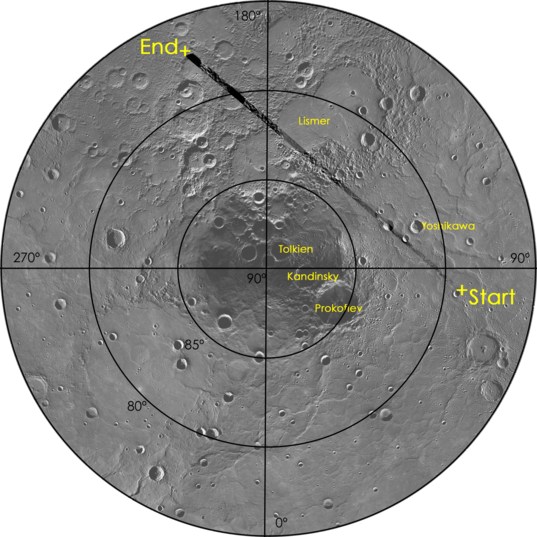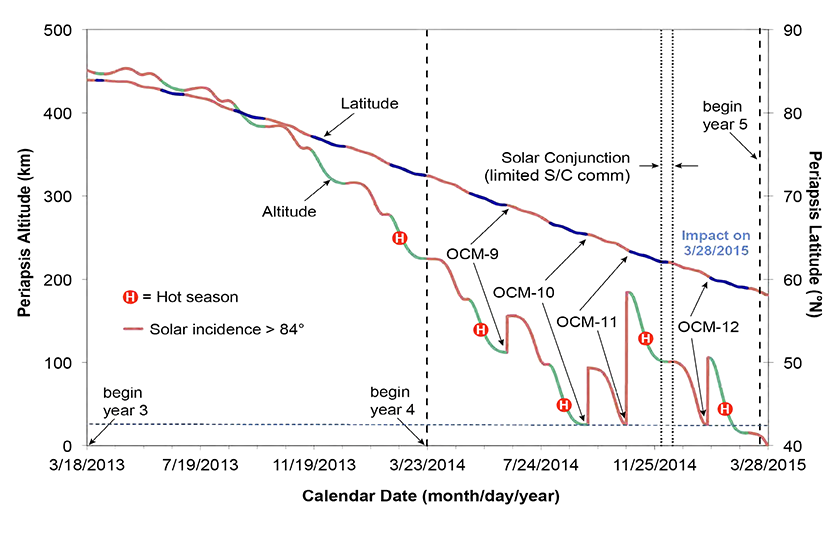JHU APL:
MESSENGER Mission News
June 17, 2014
http://messenger.jhuapl.edu/
MESSENGER Modifies Orbit to Prepare for Low-Altitude Campaign
MESSENGER successfully completed the first orbit-correction maneuver of its Second Extended Mission this morning to raise its minimum altitude above Mercury from 113.9 kilometers (70.8 miles) to 155.1 kilometers (96.4 miles). This maneuver is the first of four designed to modify the spacecraft's orbit around Mercury so as to delay the spacecraft's inevitable impact onto Mercury's surface and allow scientists to continue to gather novel information about the innermost planet.
During the primary phase of the MESSENGER mission, the spacecraft's orbit around Mercury was highly eccentric, drifting between 200 and 500 kilometers (124 to 311 miles) above Mercury's surface at closest approach, and between 15,200 and 14,900 kilometers (9,445 to 9,258 miles) above the surface at its farthest point, and completing an orbit every 12 hours. Spacecraft operators at the Johns Hopkins Applied Physics Laboratory (APL) in Laurel, Maryland, conducted several spacecraft maneuvers to counter the perturbing forces that caused MESSENGER's lowest orbital altitude to drift upward, away from its preferred observing geometry, and early in MESSENGER's First Extended Mission conducted a pair of maneuvers to reduce the orbital period to eight hours.
"In this final phase of the mission, the opposite effect is happening," explained the mission trajectory lead Jim McAdams of APL. "To extend the mission, we need to raise the minimum altitude by increasing the Mercury-relative speed of the spacecraft when it is farthest from Mercury."
For this latest orbit adjustment, MESSENGER was 82.9 million kilometers (51.5 million miles) from Earth and 69.8 million kilometers (43.3 million miles) from the Sun. The 3.2-minute-long maneuver -- which used two of the four largest monopropellant thrusters, with a small contribution from four of the 12 smallest monopropellant thrusters -- began at about 10:53 a.m., EDT. APL mission controllers verified the start of the maneuver 4.6 minutes later, when the first signals indicating spacecraft thruster activity reached MESSENGER's Mission Operations Center via NASA's Deep Space Network tracking station outside of Madrid, Spain.
"MESSENGER's results to date have revolutionized our knowledge of Mercury's global geology, the nature of volcanism across the surface, the cratering record, and the history of the planet's contraction, and they have also revealed unexpected discoveries, such as hollows," said APL's Nancy Chabot, who chairs MESSENGER's Geology Discipline Group. During the remainder of MESSENGER's mission, the focus of geological observations will narrow from a global perspective to views of selected areas in unprecedented detail, she explained.
"With the low-altitude imaging campaign, MESSENGER will acquire the highest-resolution images ever obtained of Mercury, enabling us to search for volcanic flow fronts, small-scale tectonic features, layering in crater walls, locations of impact melt, and new aspects of hollows. Those detailed views will provide a new understanding of Mercury's geological evolution," she said.
The measurement resolution of Mercury's gravity and internal magnetic fields improves markedly as the altitude of the MESSENGER spacecraft decreases. "This improvement means that smaller-scale and weaker-amplitude features can be mapped, and in the case of magnetic measurements, the external and internal fields can be separated with greater fidelity," said Roger Phillips of the Southwest Research Institute in Boulder, Colorado.
"MESSENGER will continue its downward march, interrupted by the final three orbit-correction maneuvers, but also achieving altitudes lower than 50 kilometers for the first time," said Phillips, who chairs MESSENGER's Geophysics Discipline Group. "For the magnetic field, the question of whether the crust has retained an ancient, frozen-in (remanent) magnetic field, as have Mars and Earth, can be answered, and a higher-resolution picture of the field generated by Mercury's liquid outer core can be obtained. For the gravity field, the signatures of large fold-and-thrust belts and of impact craters will shed light on the structure of the crust and the early history of Mercury."
MESSENGER's geochemical measurements obtained during the upcoming months will provide measurements with vastly improved spatial resolution, according to APL's Patrick Peplowski, the instrument scientist for the Gamma-Ray and Neutron Spectrometer. "Not only will the low-altitude campaign help our overall efforts to map Mercury's surface composition with the best possible spatial resolution, we will now be able to obtain spatially resolved measurements of features that were previously too small to resolve with the geochemical instruments," he said. "For example, we have opportunities to study the chemical composition of pyroclastic deposits and the mysterious low-reflectance material. We are also hoping to spatially resolve individual ice-hosting craters for the first time."
Even with today's maneuver, the spacecraft's altitude at closest approach will continue to decrease until raised by additional maneuvers in September and October of this year and January 2015. At that point, MESSENGER will have spent its accessible propellant, and additional altitude-changing maneuvers will not be possible. In March 2015, the spacecraft will impact the surface of Mercury, having successfully completed four years in orbit about Mercury.






